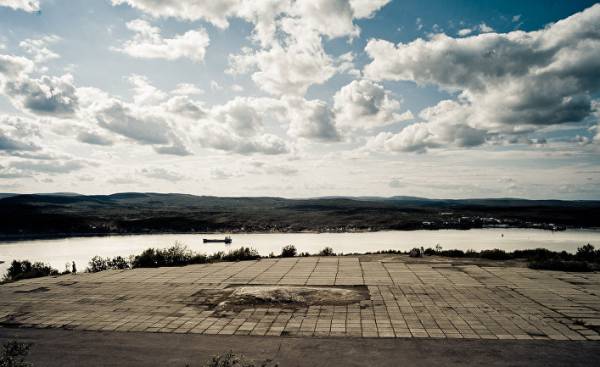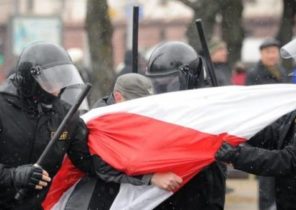
When the Soviet Union during the cold war wanted to hide something from the eyes of the rest of the world, then were all sent here. On the other side of the Arctic circle, the curves of the coast of the Barents sea, surrounded by grey rocks, black water, under a grey sky. Lichens, moss and winding birch groves scattered in the region, like a camouflage net. Even day and night do not distinguish, for six months of darkness followed by six months of gloomy light.
When the band of the Supreme command of the Northern fleet performs “Farewell of Slav”, it starts a little rain. This time Russia has invited half the world to this remote place. The Norwegian Minister of foreign Affairs, the German and British experts on reactor safety, the management of the European Bank for reconstruction and development (EBRD) and the head of the state concern Rosatom gathered this Thursday in the Pishing rain and the noise of diesel engines, to celebratory speeches and marching music to send to the first path of the special ship “Rossita”. On Board there are nine containers of radioactive waste.
Not a political thaw led to the fact that over the breakwaters near the Russian flag and waving flags of Canada, Denmark, Finland, France, Germany, Norway, the UK and the EU. Threatened disaster. For over 35 years, the Soviet Northern fleet was stored spent fuel elements from their nuclear submarines in Andreeva Bay on the Kola Peninsula. There is only slightly more than a hundred nautical miles to the waters where Norwegian fishing fleet throwing their nets.
For six years, the containers with radioactive waste will be done by Russia to the path length of 3000 km
The 1982 incident should not be repeated. Then we found a leak in the pool storage of radioactive waste have leaked hundreds of tons of radioactive water, left in the ground. In the emergency order were constructed temporary pools, displaced fuel cells. In 1992, the store was closed, but a change of temporary pools has not happened.
In the photos you can still see how it looked a few years ago. Three round swimming pools with a diameter of about 20 meters, covered with a thin layer of metal. On the sides of a ladder — storage could be mistaken for swimming pools, as they usually look in the winter in the yards of the German houses. That’s just a different issued rusting cranes and crumbling buildings, barbed wire and yellow signs — “Caution! The radioactivity!”. 22 thousands of spent fuel elements of highly enriched uranium from more than a hundred reactors of Soviet nuclear submarines are stored here in special containers, many of them damaged.
What’s around store was built a special room, the cargo terminal and special vehicle for the export of radioactive waste is the result of joint work of the border countries of the Barents and Baltic seas. At the initiative of the Environmental partnership the Northern dimension NDEP in 2002, together with Russia, a plan was developed for the safe disposal of radioactive waste. The European Bank for reconstruction and development has provided a Fund for 165 million euros to Finance the project.
Along with the countries of the North in Finance took part in the UK and Canada, Germany has allocated ten million euros. In addition, there are bilateral projects. Norway built the road to the vault, a new berth and the installation of decontamination. The UK has funded a device for the storage of spent fuel elements, Italy has built a special ship “Rossita”, the Swedes participated in the construction of the device for the storage of liquid and solid radioactive waste. Russia is responsible for the operation and processing of fuel elements.
Storage of radioactive waste only occurs remotely. The control panel is a storage room with two small Windows located around the pool. On large monitors, the engineers monitor as a special crane lowers the empty container into the hole in the floor. In seven different capsules are loaded seven fuel cells, then the containers sealed.
Containers weighing 40 tons are stored in an adjacent room as long as the Rossita will not be able to take them on Board. The container will take them to Murmansk, located 100 nautical miles. From there it will be shipped by rail to the nuclear plant “Mayak” near Chelyabinsk. According to estimates of engineers, the shipment of all fuel cells would require six years. During this time, every two months, the containers will be traveled over 3,000 km in Russia.
The engineer, who said publicly about the problem, received five years in prison
A nuclear threat to the Barents sea, thus significantly reduced. However, it does not disappear completely. The plant Nerpa at the Kola Peninsula for many years waiting for processing in China. On Board the former supply ship of the icebreaker fleet is stored more than 600 fuel cell. In accordance with another programme, promoted by the European Union, next year there should be exported the first containers of nuclear waste. In 2006 the Federal government on the initiative of the countries “big eight” has allocated $ 600 million that went into the modernization of the plant “Nerpa” and the dismantling of decommissioned nuclear submarines, were all the time on the beach.
And at Andreeva Bay while there is still unsolved problem. Behind the impressive new buildings is painted red brick building. This building No. 5, which got cracked in 1982. A number of fuel cells is still in Tignes, the area is so polluted that you can explore only by means of robotic systems. “These contaminated sites will not find anywhere else in the world,” — said the expert of the German society for radioactive protection.
But today the situation is less dangerous than it was a decade ago, says Vince Novak, senior specialist, nuclear safety European Bank for reconstruction and development. Of course, you can raise the question of why Europe gave the Soviet Union so much money on the disposal of radioactive waste, while at the same time Russia is investing in new weapons. Some members of the German delegation spoke of “schizophrenia”. But this is not about altruism, Nowak says. “Radioactive contamination knows no borders.” Storage of radioactive waste — the investment of all involved in their own safety — like position, as in the case of Chernobyl, where the European Bank for reconstruction and development is also involved.
All participants of the project in the North sea breathed a sigh of relief that the project, despite tense relations between Moscow and the West, was completed. Due to the annexation of Crimea and the war waged by Russia in Ukraine, the EBRD since July 2014, no longer funding programs for Russia. In may, the Minister of economy of Russia Maxim Oreshkin said that the EBRD is no longer a support institution development, and is a “foreign policy tool”. But funding for the facility in the Andreeva Bay no one under question is not raised. Pierre Heilbronn, Deputy President of EBRD, said on Tuesday at Andreeva Bay: “it is Particularly gratifying to see that States have put aside their differences to solve such important problems, as residual elements of the nuclear Navy.”
When on Tuesday, the ship with the first containers left the Andreeva Bay, on the shore among the guests of honor stood 65-year-old Alexander Nikitin, he was an engineer of the Northern fleet and later head of the division for nuclear safety. He was the one who launched this whole process. After his discharge from service in 1994, wrote in an article about the dangers of radioactive waste remaining after the end of the cold war, and appealed to the Norwegian environmental organization Bellona. When the FSB in 1995 charged him for disclosure of state secrets, in the process, the danger around the Barents sea became available to the public worldwide. After five years in prison, the Supreme court acquitted him on all charges.
Russia in 2014 и2016 years declared the organization associated with Bellona in Murmansk and St. Petersburg, “foreign agents” because they receive too much money from the Norwegian partners, according to the Ministry of justice, were too politically active. However, former colleagues of Alexander Nikitin still invited. Meanwhile, he is a member of the Advisory Board of Rosatom.







